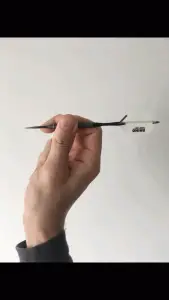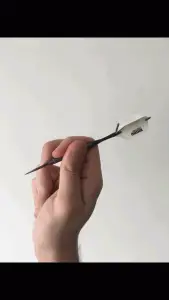When learning to throw darts, the way you grip them will have the single biggest impact on how quickly you can pick up the game and more importantly, start throwing darts with accuracy.
You might think it’s an instinctual thing to pick up a dart and throw it, however, the way you hold a dart will drastically impact how accurately you can throw it – even for beginners.
If you’re holding the dart wrong, chances are you’re going to really struggle to get better at darts.
In this guide, we’ll show you how to hold a dart while demonstrating finger placements and types of grip that will feel most comfortable for you.
Key Takeaways
- Hold a dart with a relaxed grip (don’t grip it tightly)
- Ensure the darts is flat and the tip is pointing at the board when aiming
- Choose a finger placement that matches your darts shape and weight distribution
How to Hold a Dart
To grip a dart, start by picking it up and holding it the same way that you would hold a pen, this is the grip that will feel most natural and will be your starting point.
- Use your thumb and forefinger to support the weight of the dart. This doesn’t need to be too firm, just enough so that when you hold the dart up it stays in the same position in your hand without rolling.
- The position of where you hold the dart will vary depending on the shape of the dart so just look for a position where the weight is evenly distributed. The dart should be straight and flat when pointed at the board.
- The above two points are the support structure for your grip, to stabilize and aim the dart you will now add your middle finger to the area where the point and barrel meet. You can move this finger closer to the end of the point or further up the barrel depending on what feels most comfortable.
Holding a dart seems like it would be the easiest part of playing darts, however, as is the case in most sports there are certain best practices and guidelines behind holding and gripping a dart.
Your first focus should be on finding a comfortable grip that allows you to keep the dart stable and flat when pointed at the board.

You will want to keep the dart stable and flat in order to improve trajectory and accuracy. If your dart is angled and the point is lined up pointing down instead of at your target then this could lead your dart hitting the board at a less than ideal angle.

When holding a dart in a comfortable position you then want to be focusing on how you are gripping the dart in terms of force.
If you hold the dart too tightly then it will be difficult to release the dart with a smooth motion whereas if you are holding a dart too loosely then the release will again be compromised and may lead to the dart wobbling in the air and becoming less accurate.
A good dart grip can be described as firm so that when you hold it it doesn’t move around in your hand but also relaxed enough so that it won’t have any impact on how you release the dart.
You shouldn’t have any muscles of the hand or forearm tensed whilst gripping a dart, if you do then this is a sure sign that your grip is too tight.
A dart throw is intricate, if you need to use more fingers than recommended in order to hold the dart stable then this would be a better option than gripping it with fewer fingers – but tightly with force.
The single best way to determine if you are holding the dart with a firm enough grip is to take a natural grip of the dart and move your wrist up and down, if you can do this freely without the dart moving (except in the up and down motion in line with the wrist) then you know that your grip is just right.
To do this just imagine you are shaking someone’s hand, that should be the motion.
If you move your wrist up and down but need to tense your muscles to keep it steady then your grip is too tight.
Alternatively if during this test the dart shakes and wobbles during the movement then your grip is too loose and you should modify it by either using more fingers to stabilize the dart or changing the position in which you hold the dart.
Factors That Affect How You Hold a Dart
Darts come in many shapes, weights and sizes, therefore the way you grip one dart will not necessarily transfer over to how you grip another dart.
A dart that is front weighted (carrot shaped) may require a wider grip closer to the point when compared with a slim, evenly balanced barrel whereby you could comfortably grip the dart center barrel and still maintain stability of the dart.
It’s therefore important to find a dart that suits you early on and try to stick to a similar shape and design when changing darts in the future.
The reason I say this is because the above scenario happened to me and I was forced to change grip midway through a league season.
My first ever dart set was a unicorn model based on John Lowes dart design. It wasn’t an expensive set of darts costing £15 (<$20), however it was the set that I got used to and learned to play the game with.
The barrel of this dart was large and round at the point and then tapered in to be slimmer at the stem. I therefore had to grip the dart at the point where the barrel meets the point in order to stabilize the dart and this is the grip I developed with.
Once I joined the Manchester slip up league, which is played on the Manchester board (Check out dartboard types here) and has significantly smaller doubles than a regular board, I was finding it difficult to play well on because my dart barrels were so big that they would block the numbers if I grouped my darts too closely.
Throwing too close would normally be a good sign of accuracy however in this instance it was more of an issue!
I therefore made the decision to upgrade my set to a slimmer dart that would allow for better grouping. This was all well in theory however what I hadn’t factored in was that I could no longer use the same grip to hold the dart, it was too slim to grip based on my adopted style of grip.
It therefore took some adjusting over the space of a few weeks but I finally adapted to a new grip style and that is the key consideration when developing your grip.
If you do so based on a specific style of dart then this will not necessarily transfer over to other darts.
Different Dart Grips
Everyone will grip a dart differently and while there are some common tips you can follow for a better grip (like having a firm, not tight grip), the way you grip the dart may be very different from many of the pros.
This is fine though.
Even really unorthodox throwing styles like Mensur Suljovic can still lead you to the pro stage.
To generalize, there are three different broad grips:
- Front Grip
- Middle (balanced) Grip
- Rear Grip
How you hold a dart relates to finger placement, firmness, etc… When it comes to grip, however, people will often be referring to the position where they hold the dart. A front gripper will have more fingers towards the front of the barrel and will have more touch points on the dart point.
A rear gripper will hold the back of the barrel and maybe even the dart stem. A middle grip will be a grip where you mainly hold the dart by the central point of the barrel (with some touch points on the dart point or stem).
How Many Fingers Should You Hold a Dart With?
There are a few factors that will come into play when it comes to finger placement and ultimately how many contact points you have with the dart (this is how many points of contact you have with the dart which include the point, barrel and stem).
A top heavy dart may require you to hold the dart closer to the point, reducing the amount of fingers you could ultimately use whereas a long dart that’s well balanced may require more fingers in order to hold the dart stable.
There is no right way when it comes to how many fingers you use or where you place them on the dart and it should be specific to the dart that you are using and your comfort level. As long as the dart is stable and under a firm grip then this is a good position.
Is There a Wrong Way to Hold a Dart?
As I’ve briefly covered earlier, finger position on a dart is one of the key components when it comes to having a stable grip. One of the worst habits you can adopt when learning to throw darts is to use a clenched fist as this will negatively impact your release.
A smooth release of your dart will come down to finger placement balanced with a firm grip.
You should never hold a dart with a tight grip or clenched fist. This will make it too difficult to release the dart smoothly and you will see the dart drop too low from where you are aiming as a result. You should also avoid holding a dart with the pointing tilted downward.
Related – Why do my darts keep dropping too low
What Next
Everyone will have a unique grip and way to hold a dart. It’s like holding a pencil, you should first start with what feels most comfortable. By using some of the tweaks above though, you may be able to improve your grip and ultimately throw with more accuracy and consistency.
If you’re moving past the beginner stage in darts, check out our guide on calculating dart averages and also how to improve your dart averages to start moving towards an intermediate and competitive playing standard.
If you’ve got an issue with physically gripping or releasing the dart then it’s also worth looking into dartitis to see if you have any of the symptoms.

